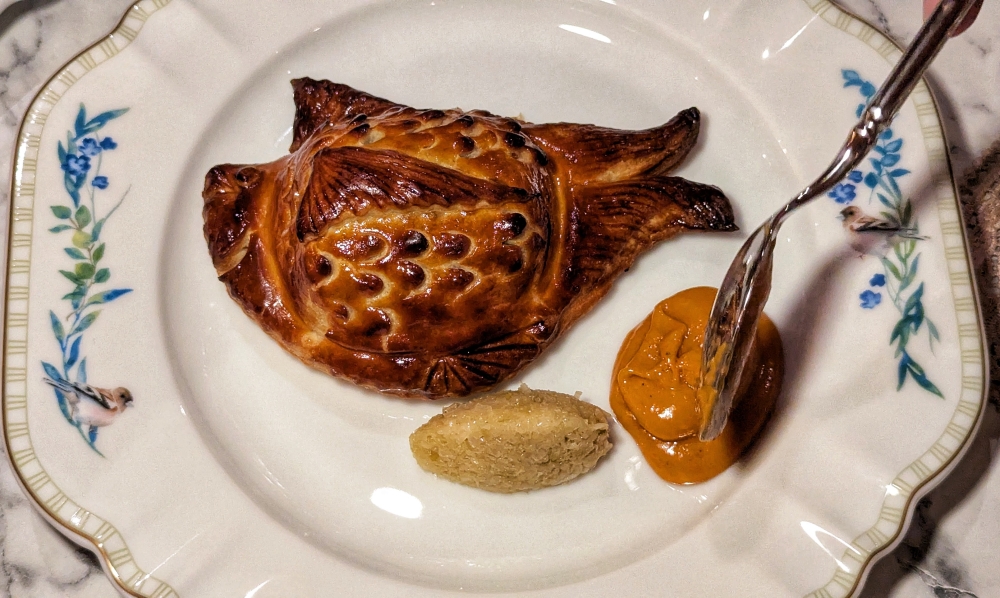KUALA LUMPUR, March 28 — When Darren Teoh opened Dewakan 10 years ago, the idea of highlighting local produce in a fine-dining setting was novel, even for Malaysia’s tasting-menu connoisseurs.
What began on a university campus, overlooking students playing futsal in the foyer, became the defining name in modern Malaysian cuisine.
In 2019, it became the first and only Malaysian restaurant on Asia’s 50 Best Restaurants list at No. 46.
A move to a swankier downtown location followed, and in 2022, it returned at No. 50. Yet one question has persisted: is it “worth it”?
Can locally sourced game and foraged ingredients like dabai and kulim really satisfy diners accustomed to A5 wagyu, Beluga caviar and foie gras?
A Michelin star in the guide’s inaugural Malaysian edition, followed by a second in 2023, only deepened the debate.
Last week, Teoh soft-launched Bidou, a French restaurant the chef revealed earlier this month in an interview with Malay Mail.
He described the concept as four years in the making, drawing from his French culinary background, which includes a stint at Singapore’s famed haute restaurant Les Amis, and a dish-forward approach to contemporising nouvelle cuisine — the light, elegant style pioneered by icons like the Troisgros brothers and Paul Bocuse, which moved away from the butter-laden opulence of cuisine classique in favour of fresher flavours and more delicate techniques.
The main dining room at Bidou (left). A framed copy of the menu from Restaurant Paul Bocuse (right) — Pictures by Ethan Lau
Bidou’s markedly different approach might spare it from its older sibling’s debates.
While diners have grown more accepting of local produce in high-end restaurants, French cuisine retains a cachet built over centuries, and the recent renaissance of bistros and other French-inspired throwbacks suggest a resurgence in KL’s dining consciousness.
But beyond all that, the most obvious difference is the price.
At Bidou, RM377 nett offers a four-course experience that gives you a taste of the acclaimed chef’s approach to French cooking, a stark contrast to the RM870 nett price tag and nearly three-hour commitment of Dewakan. There’s also a three-course option for RM299 nett too.
Bidou’s home is a cosy shophouse in Jalan Setiakasih, in a quieter part of Bukit Damansara.
Its pastel yellow exterior stands apart from the surrounding shops, as do the ornate lamps and the narrow staircase leading to the main dining room.
Downstairs, a private space accommodates at least 14.
The two words I’d use to describe the dining room are “warm” and “French.”
Earthy hues dominate, from the orange walls to ochre sofa booths.
While the room is too bright and the tables too well spaced to be totalement français, the fine Legle Porcelain tableware looks straight out of a bourgeois home.
Everything from a portrait of Batman (a childhood hero of Teoh’s) to a series of witty Bibendums (one winks: Sorry sweetie, your sous-vide truffle-infused quail egg didn’t amuse my bouche) adorn the walls, but the most telling might be a framed menu from Restaurant Paul Bocuse — a chapeau to one of the restaurant’s inspirations.
Nowhere is the influence of nouvelle cuisine more apparent than in the first course of the prix fixe menu.
Bidou’s take on Michel Guérard’s salade gourmande presents wafer-thin slivers of radish dotting a garden of asparagus, lettuce, chicory and green beans — crunchy, tasting like the green of spring — alongside a smooth, rich block of foie gras wedged between a delicate almond tuile, with a spread of plum jam for sweetness.
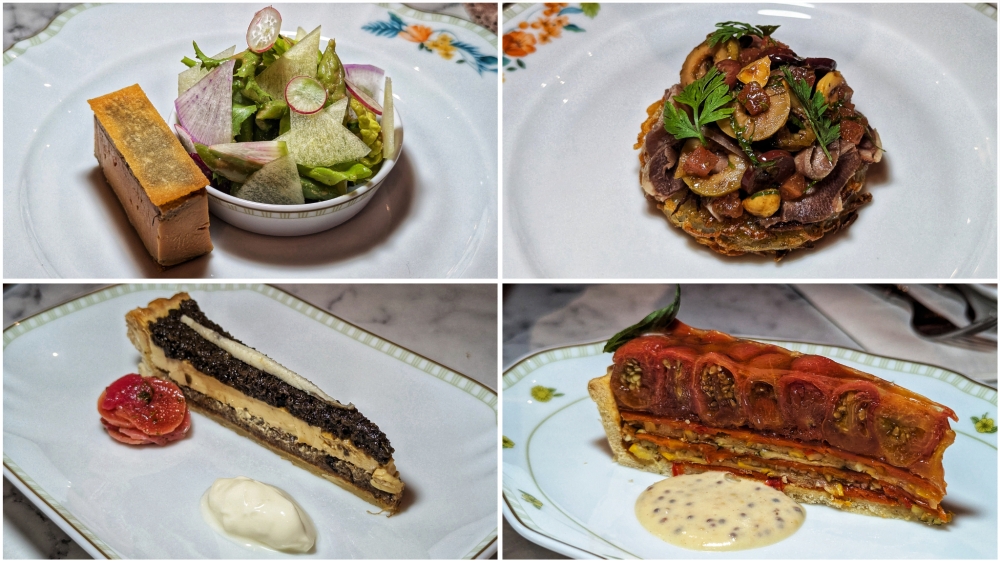
Clockwise from top left: ‘salade gourmande Michel Guérard’, ‘langue de boeuf Provencale’, ‘tarte aux tomates de Daniel Calvert’, ‘tart mouginoise Roger Verge’ — Pictures by Ethan Lau
Alternatively, head to Provence for a crispy disc of pommes Darphin topped with ribbons of thinly sliced beef tongue, studded with briny olives, likely Niçoise, for a punch of salt and depth.
Even the two tarts play with the palate.
Bidou’s version of Roger Vergé’s tart mouginoise meticulously extracts every ounce of flavour from caramelised onions and olives, so that the tiny portion is packed with sweetness and brine, balanced by a dollop of crème fraîche.
The other nods to a modern star, Daniel Calvert of Sézanne, Tokyo, with a tomato tart that turns out to be the meatiest, heaviest-tasting dish of this section.
The mustard sauce, a swap of burrata olive oil sauce used in the original dish, served on the side is an excellent foil.
The second course is a stage for the classics.
Consommé de Hélène arrives unassumingly, its pale gold broth poured tableside into the bowl, its concentrated beef and tomato flavours enveloping delicate bites of egg white custard and profiteroles.
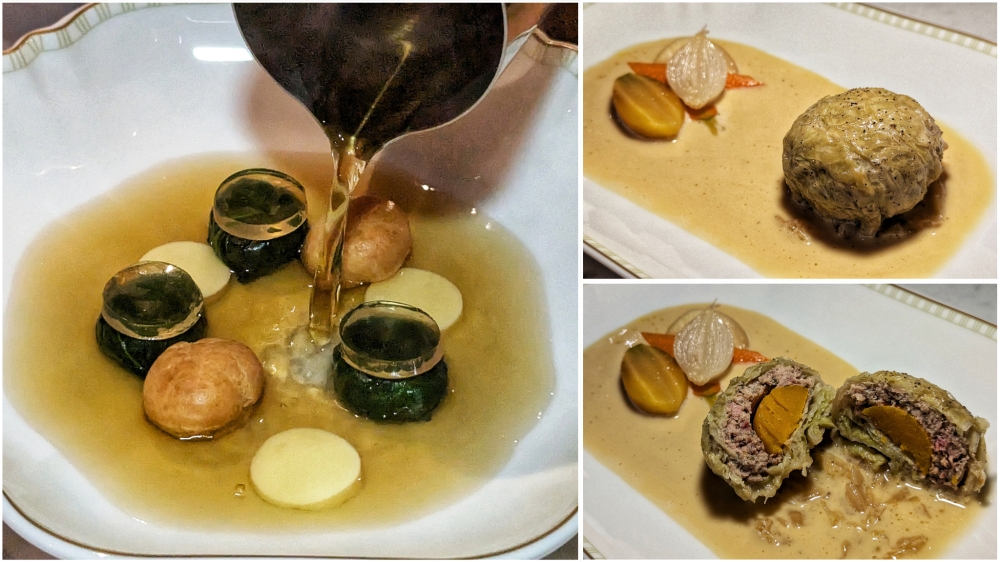
‘Consommé de Hélène’ is an unassuming but masterful second course (left). ‘Chou farci’ is an old-school classic rarely found in KL (right) — Pictures by Ethan Lau
A prawn ball wrapped in spinach adds an interesting texture, topped with a touch of sweet white wine jelly.
Another option is the chou farci, a true old-school icon rarely seen in KL.
A farce of duck and chicken encases a wedge of pumpkin, the whole parcel wrapped in cabbage leaves and braised until tender.
A creamy pumpkin sauce nage ties it all together, adding a touch of sweetness.
Old-fashioned yet impeccably executed, made exciting.
The statement piece, however, is undoubtedly the pâté en croûte: a tapestry of duck and chicken forcemeat, with a circle of foie gras at its centre, flecked with green pistachios and framed by pastry crust.
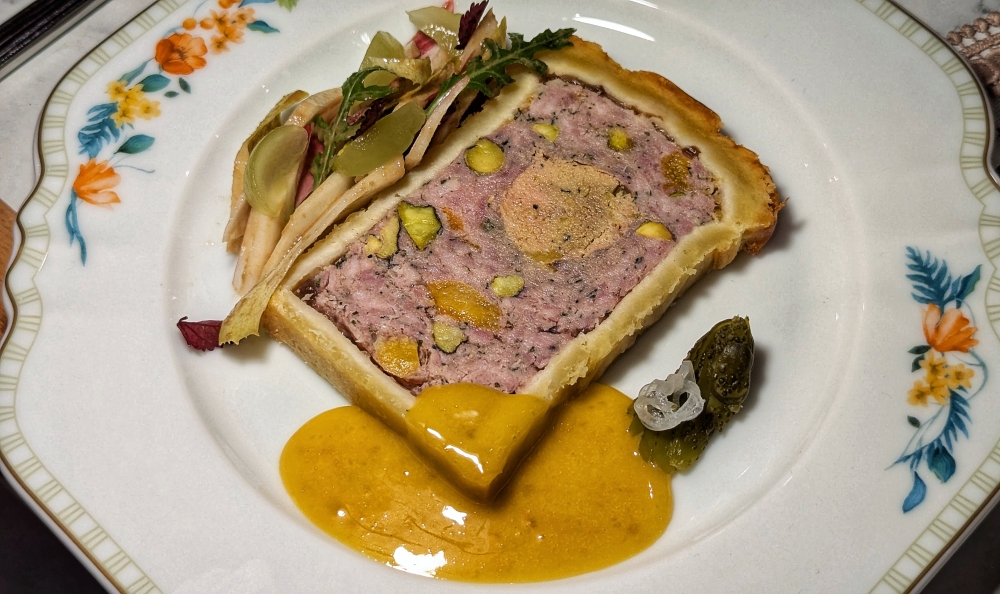
Bidou’s take on ‘pâté en croûte’ is as delicious as it is gorgeous — Pictures by Ethan Lau
On one corner, a pool of Maltaise sauce, the tangier and zestier sibling of Hollandaise, brightened with blood orange, glistens like gold lacquer.
A salad of endive and grape, bitter and sweet, cuts through the richness.
In the main course, Bidou one-ups this with a stunning take on Paul Bocuse’s classic loup en croûte.
Their version features seabass with a scallop mousse encased in a beautifully bronzed puff pastry shell shaped like a fish, served with a quenelle of leek fondue on the side.
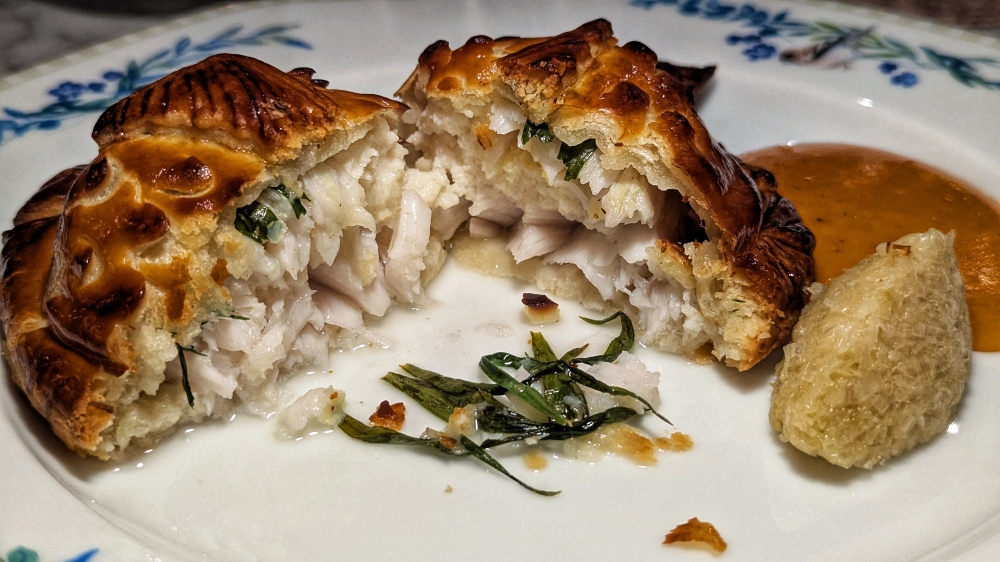
The ‘loup en croute’ contains flaky seabass and scallop mousse inside the pastry shell — Picture by Ethan Lau
True to the original — which keen-eyed diners might spot on the framed menu — a server finishes the dish tableside with a spoonful of Choron sauce, a richer, tangier spin on Béarnaise brightened with tomato paste.
Cut through the crisp pastry to reveal delicate flaky fish layered with springy mousse, daub it generously with sauce, then chase the bite with the sweet, melting leek.
A dish that invokes 20th-century theatricality and grandeur without falling into pomp, as refined in execution as in presentation — easily the pièce de résistance of the menu.
If your dining companion is more in touch with their investments than their emotions, fret not — there is steak.
Grilled to a perfect blushing pink from end to end, it’s served with an anchovy butter sauce that delivers all the salty, savoury depth of anchovy without the fishiness, like a more elegant gentleman’s relish.
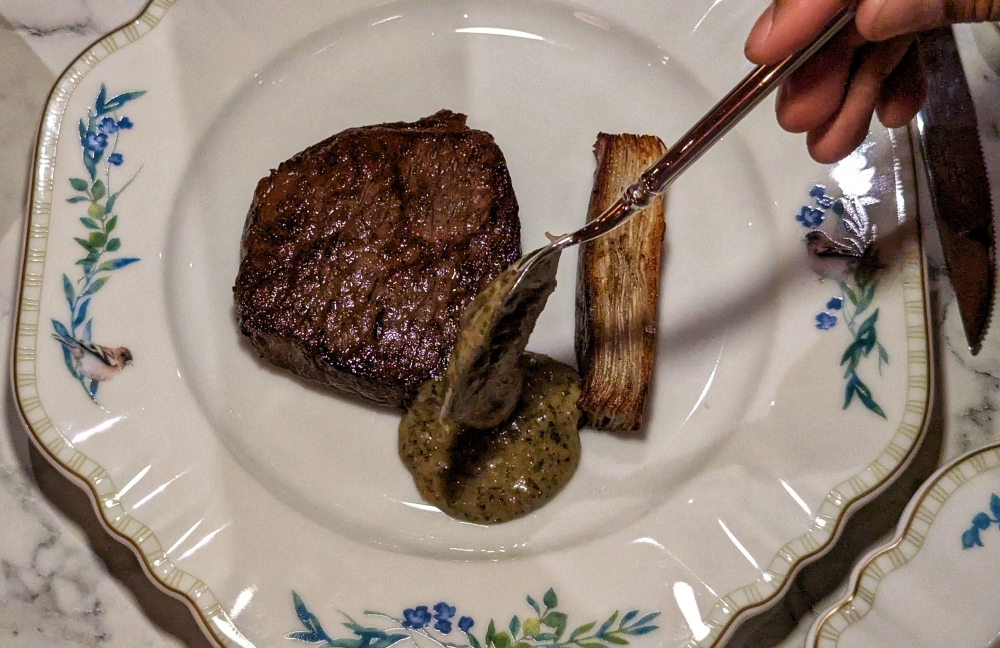
Even steak here is refined, served with a brilliant anchovy butter sauce — Picture by Ethan Lau
Even the potato pavé refuses to be “simple,” its layers spliced with celeriac for a bitter edge rather than a cloying richness.
There are three dessert options, with Bidou managing to slip in one last homage to a culinary great: Fernand Point and his iconic marjolaine.
This light, flourless cake is built with intricate layers of chocolate ganache, nutted meringue, and pastry cream, here paired with plum ice cream for a hint of tartness.
Then there’s the clever tarte aux châtaignes, a slice of chestnut tart served with smoky chocolate ice cream laced with black cardamom, topped with a slim piece of salted chocolate.
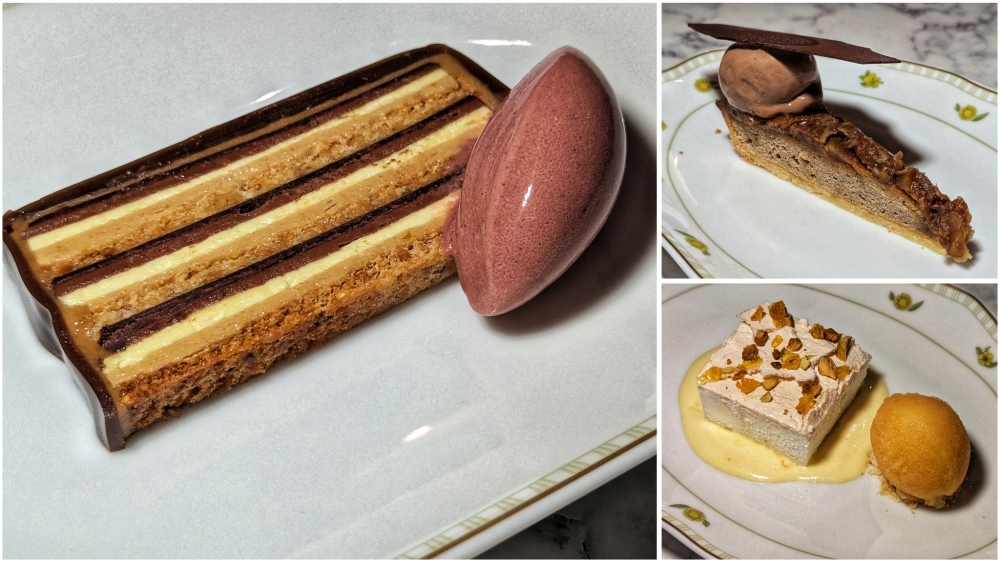
Trio of desserts: ‘marjolaine de Fernand Point’ (left), ‘tarte aux chantaigne’ (top right) and îles flottantes (bottom right) — Pictures by Ethan Lau
Rich, layered with depth, and never “too sweet.”
But the most tantalising has to be the îles flottantes.
Traditionally made with baked meringue floating on crème anglaise, Bidou’s version puts orange at the forefront, with poached meringue — soft the way you wish marshmallows could be — lounging in a pool of orange-tinged crème anglaise, alongside a sphere of blood orange ice cream.
A blissfully refreshing yet satisfying finish to what is, in fact, a surprisingly light meal.
No matter your choices, you’ll likely leave feeling limber rather than sluggish.
Light, yet deeply satisfying.
The cooking was never lacking in skill, technique, execution, or flair — a tour de force of French cuisine, steeped in reverence for the pioneers whose innovations became tradition, faithfully carried forward with precision and care.
Bidou
9, Jalan Setiakasih 5,
Bukit Damansara, Kuala Lumpur
Open Wednesday to Monday, 6pm till late. Last table at 9pm.
Tel: 012-278 6720
Instagram: @bidoumy
* This is an independent review where the writer paid for the meal.
* Follow us on Instagram @eatdrinkmm for more food gems.
* Follow Ethan Lau on Instagram @eatenlau for more musings on food and mildly self-deprecating attempts at humour.


